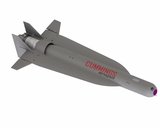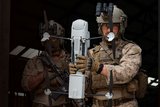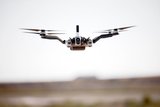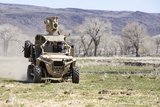CBP Completes Unmanned Aircraft Surveillance in Great Lakes Region
US Customs and Border Protection's Office of Air and Marine announced that it concluded surveillance operations along the U.S. side of the maritime border of Lake Ontario and St. Lawrence Seaway, and the land border of New York and Ontario on June 25, 2009.
As part of a multi-agency effort called Operation Empire Shield, CBP deployed a Predator B unmanned aircraft system (UAS) and P-3 aircraft to the Northern Border to perform law enforcement operations.
"The deployment was exceptional," said Michael Kostelnik, CBP Assistant Commissioner for the Office of Air and Marine. "Operational objectives were met, and interagency and bilateral relationships were established and expanded.
The operation was designed to demonstrate unmanned aircraft operations and evaluate law enforcement coordination concepts over both land and maritime environments at the Northern Border. An after action assessment, which will be completed in coordination with multiple CBP offices, will be used to prepare for future UAS expansion.
CBP currently has six Predator B aircraft that provide unique border security surveillance capacity through superior optical equipment coupled with extended flight duration. CBP's unmanned aircraft typically fly up at 250 knots at an altitude of 19,000 feet while carrying up to 3,000 pounds of sensors for land and maritime surveillance and tracking in day and night environments.
Operation Empire Shield included a number of firsts for CBP's UAS program. On Saturday, June 20, 2009, CBP demonstrated the capability to fly and operate three UAS aircraft simultaneously in the National Airspace System via satellite.
On June 20th, UAS from North Dakota and Arizona were launched and executed law enforcement missions within their respective airspace. An hour later, the third UAS was launched from Wheeler-Sack Army Airfield in Fort Drum, New York and control of the remotely piloted aircraft was seamlessly transferred to a crew operating from the Air and Marine Operations Center in Riverside, California. All three aircraft performed law enforcement missions including streaming live video to select members of law enforcement, homeland security, and members of the U.S. Congress.
CBP also established a milestone by completing its longest duration UAS flight. On June 24, 2009, the UAS landed in New York after flying over 20 hours. The ability to fly for 20 hours is approximately twice the endurance of most manned aircraft, offering a unique and persistent surveillance capability to secure the homeland.
During this endurance mission, control of the UAS was passed between UAS operations centers located at New York, North Dakota, and Arizona.
The nearly 100 hours of CBP UAS flight operations in the Northeast are just one component of an integrated law-enforcement effort to secure the region. The UAS deployment serves as an exceptional opportunity for other law enforcement partners to participate and refine concepts of operations when working with advanced aircraft such as CBP's Predator B UAS and the P-3.
CBP Air and Marine continues to serve as a critical component and advocate of DHS' Secure Border Initiative. Advanced security operations such as CBP's UAS deployment along the Northern Border is a vital element of this strategy.
The Federal Aviation Administration remains a key facilitator and partner of CBP Air and Marine, helping to ensure CBP UAS flights in the Northeast integrate safely and seamlessly with other aircraft operating in the region.
More from Uncrewed Vehicles
-
![Cummings Aerospace showcases Hellhound loitering munition designed for US Army’s LASSO programme (video)]()
Cummings Aerospace showcases Hellhound loitering munition designed for US Army’s LASSO programme (video)
Cummings Aerospace presented its turbojet-powered Hellhound loitering munition at SOF Week 2025, offering a man-portable solution aligned with the US Army’s LASSO requirements.
-
![SOF Week 2025: PDW unveils attritable FPV drone for SOF operations at scale]()
SOF Week 2025: PDW unveils attritable FPV drone for SOF operations at scale
PDW has revealed its Attritable Multirotor First Person View drone at SOF Week 2025, offering special operations forces a low-cost, rapidly deployable platform for strike and ISR missions, inspired by battlefield lessons from Ukraine.
-
![SOF Week 2025: Teledyne FLIR white paper provides guidance on reusable loitering munitions]()
SOF Week 2025: Teledyne FLIR white paper provides guidance on reusable loitering munitions
Teledyne FLIR is highlighting the emerging requirements for 'recoverable and re-usable' loitering munitions across the contemporary operating environment during this week’s SOF Week conference in Tampa, Florida.
-
![SOF Week 2025: Kraken Technology group debuts K3 Scout USV in North America]()
SOF Week 2025: Kraken Technology group debuts K3 Scout USV in North America
High-performance maritime industry player Kraken Technology Group, based in the UK, has used the SOF Week conference in Tampa, Florida this week to debut its K3 Scout uncrewed surface vessel (USV) to the North American market.
-
![Palladyne AI and Red Cat to demonstrate capabilities for autonomous drone swarms to the US military]()
Palladyne AI and Red Cat to demonstrate capabilities for autonomous drone swarms to the US military
Red Cat and Palladyne AI recently conducted a cross-platform collaborative flight involving three diverse heterogeneous drones.
-
Jammer resistant drone designs spark search for countermeasures
The Russia-Ukraine conflict has driven another stage of evolution for drones and the counter measures to defend against them.























